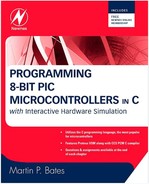Assessment 4 5 points each, total 100
1. Sketch a full bridge driver circuit using PFETs and NFETs connected to a motor, indicating the current flow for forward motion and the logic state of the FET inputs.
2. Calculate the speed of the stepper motor on the mechatronics board in rev/min if it is driven at a rate of six steps per second.
3. Derive a formula for the output of the temperature sensor on the mechatronics board, in the form V=f(t).
4. Suggest three disadvantages of using the 3.5-digit parallel LCD compared with the serial alphanumeric display described in Part 2.
5. Write a statement to display the number ‘8’ on digit 1 on the mechatronics board LCD, and explain the meaning of each element of the statement.
6. Describe briefly the hardware used to control the speed of a DC motor connected to a microcontroller.
7. Outline how the position of the stepper motor on the mechatronics board is controlled and the connections required.
8. Outline a method for controlling the speed of the DC motor in the mechatronics board, using Timer1 in the MCU to measure the sensor pulse period.
9. Calculate the delay required in the STEPTEST Program to run the stepper motor at about 1 rev/sec (full step mode).
10. The temperature sensor on the mechatronics board has a calibrated output, while the light sensor does not. Explain why the comparator interface is therefore appropriate for light sensing but the ADC would be preferred for temperature measurement.
11. The temperature at the mechatronics board sensor is 25°C and is converted by the 10-bit ADC with a reference voltage of 2.048 V. Calculate the ADC output value.
12. Write down logic functions for the Source (Pg.Ng) and Sink (!Pg.!Ng) conditions of the board driver logic in terms of the input variables P, M, N, and F from the logic states shown in Table 4.8.
13. List the hardware links required for the bidirectional DC motor drive in the mechatronics board, and explain their significance in terms of switching the current in the bridge forward, reverse, and off.
14. State the connections required for the stepper motor drive in the mechatronics board, and list the activation sequence required at the drive logic inputs.
15. State the features of the power MOSFET that make it suitable for use as a current driver device.
16. Refer to the simulation schematic Figure 4.14and calculate the output voltage of the overcurrent amplifier in the mechatronics board simulation circuit when the test pot is set to its mid-position.
17. Refer to the simulation schematic Figure 4.14and explain briefly how the overcurrent latch functions.
18. Explain briefly why a PMOSFET and an NMOSFET are needed in each half-bridge driver stage.
19. Outline how to set up the mechatronics board to control the speed of the DC motor in one direction only, and state the required output from the MCU.
20. Study the setup for stepper motor driving in full-bridge mode; and by using the drive logic functions, determine the winding activation sequence, in terms of the current flow between drive terminals 1, 2, 3, and 4.
